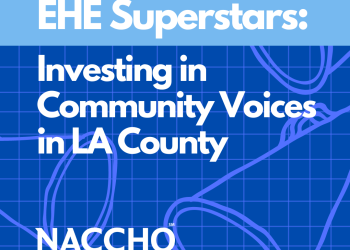Harm Reduction
Harm reduction refers to a set of strategies that reduce the harms associated with substance use. By meeting people where they are, harm reduction providers build trust with people who use drugs (PWUD), equipping them with the tools and information to protect themselves from infectious diseases and overdose.
Syringe services programs (SSPs) are an effective, safe, and cost-saving strategy to prevent the spread of HIV and viral hepatitis. Comprehensive SSPs offer syringe distribution and disposal, conduct education and counseling, and provide or refer clients to HIV, STI, hepatitis, and substance use disorder services. They may also distribute the overdose reversal medication naloxone, fentanyl test strips, condoms, or other supplies to prevent infectious diseases or overdose.
Local health departments (LHDs) play a critical role in providing and supporting harm reduction services. NACCHO supports LHDs by increasing buy-in, facilitating peer learning and engagement, and providing technical and capacity building assistance for harm reduction programs.
The work of local health departments (LHDs) has been severely impacted since the onset of the COVID-19 pandemic. Much of their staff has been activated as part of an emergency response to combat the virus, and many of their day-to-day activities have been suspended or are operating at a reduced capacity. Read more about the impact of COVID-19 on HIV, STI, viral hepatitis, and overdose response activities at at LHDs in our below Reports from the Field.
In the wake of the 2015 HIV outbreak in Scott County, Indiana – and in response to the Centers for Disease Control and Prevention’s (CDC’s) vulnerability assessment, which identified 220 counties most vulnerable to an outbreak of hepatitis C and HIV among PWID – the LENOWISCO Health District of the Virginia Department of Health initiated efforts to develop a comprehensive community response plan to address this vulnerability. The District, made up of four localities in rural southwest Virginia - Lee, Norton, Wise, and Scott - has been heavily impacted by the opioid epidemic and two of its counties were identified in the CDC’s assessment.
Read Community Response Planning for Outbreaks of Hepatitis and HIV Among People Who Inject Drugs: A Case Study from the LENOWISCO Health District, a Rural Community in Virginia to learn about the process the health department took for developing the Community Response Plan, lessons learned, and next steps for putting the plan into action. The full document is 138 pages, but each component can be individually accessed below:
| Webinar Title | Description | Slides | Date | Additional Resources |
|---|---|---|---|---|
| Smoking Supplies Webinar | The distribution of smoking supplies has emerged as a promising harm reduction strategy to engage people who use drugs, reduce overdoses, and prevent infectious diseases. In March 2023, NACCHO conducted a survey to better understand the implementation of smoking supplies, including the impact and benefits, factors that support this work, and barriers that undermine it. On July 31st, NACCHO shared the results of the survey and two organizations, The Phoenix Center and Public Health Madison Dane County, shared their experience with implementing smoking supplies. | Slides | July 31, 2023 | Blog post with additional resources |
For questions about NACCHO's work regarding harm reduction, contact our harm reduction specialists below.
Community Health Program
Julie Karr
Senior Program Analyst, Harm Reduction
JavaScript is required to reveal this message. / Email
Community Health Program
Anjana Rao
Program Analyst, Harm Reduction
JavaScript is required to reveal this message. / Email
Community Health Program
Kat Kelley
Lead Analyst – Syndemics - HIV, STIs, Viral Hepatitis, & Harm Reduction
JavaScript is required to reveal this message. / Email
Communications
Grace Murtha
Communications Specialist
JavaScript is required to reveal this message. / Email
Community Health Program
Randy May
Director, HIV & Harm Reduction
JavaScript is required to reveal this message. / Email


